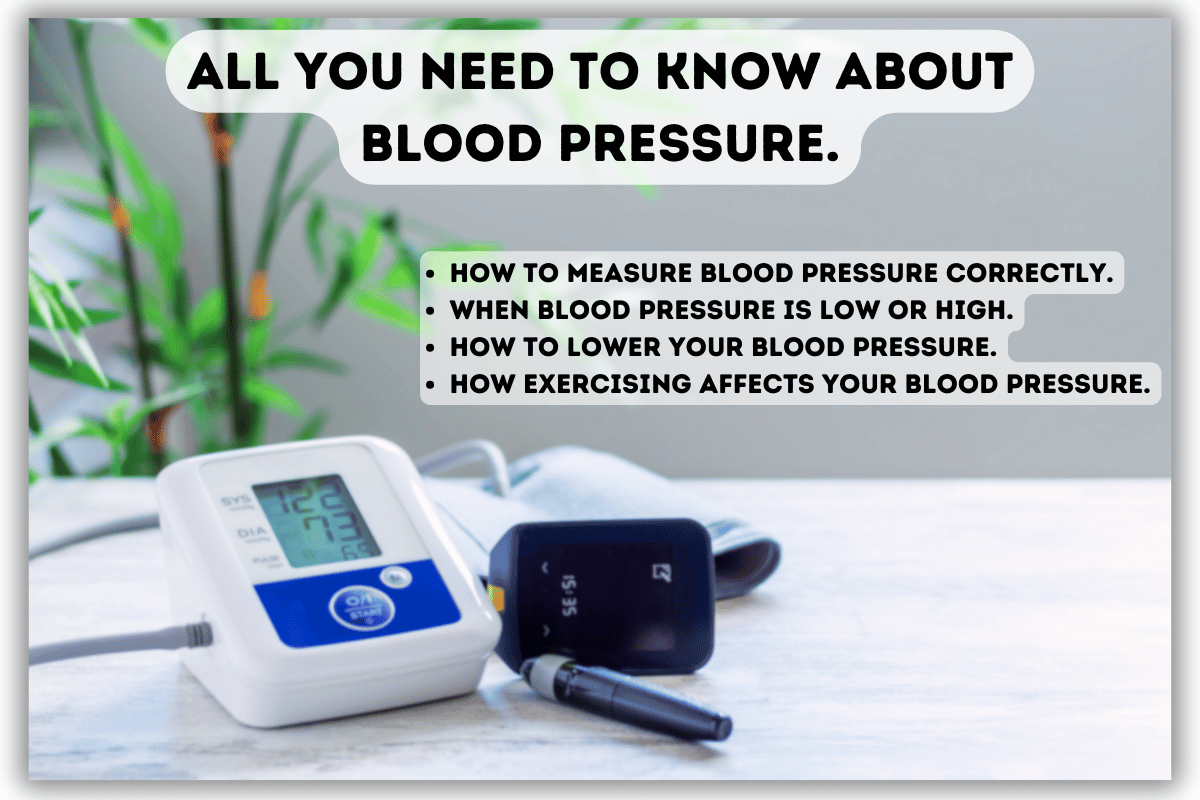Blood pressure is a measure of the force that blood applies to the walls of the arteries when it flows through them. We are measuring blood pressure using two numerical readings, Systolic and Diastolic blood pressure. Systolic blood pressure is the pressure exerted on the artery walls during the contraction phase of the heartbeat. Diastolic blood pressure is the pressure exerted on the artery walls during the relaxation phase of the heartbeat. When we have normal blood pressure, our blood delivers food and oxygen to the different parts of the body and doesn’t create any damage to the blood vessels. When our blood pressure is high, it creates more pressure and damages blood vessels. It is the reason for health problems like strokes, heart attacks, heart and kidney failure, dementia and sexual dysfunction. In this article, we will look at how to measure blood pressure correctly, blood pressure classifications (when blood pressure is low or high), how to lower your blood pressure by improving your lifestyle and how exercising affects your blood pressure.
The regular blood pressure readings are 120 (Systolic)/80 (Diastolic). A blood pressure of 140/90 is considered to be high. For people with blood pressure readings above 144/94, it is recommended to consult their doctor before participating in physical activity. Individuals with readings above 180/110 shouldn’t participate in physical activities. People with low blood pressure also should consult with their doctor first. Below is a table which explains blood pressure classifications (when blood pressure is high or low).
| CATEGORY | SYSTOLIC | DIASTOLIC |
| Low | <100 | <60 |
| Optimal | <120 | <80 |
| Normal | <130 | <85 |
| High normal – Pre-hypertension | 130-139 | 85-89 |
| Stage 1 Hypertension | 140-159 | 90-99 |
| Stage 2 Hypertension | 160-179 | 100-109 |
| Stage 3 Hypertension | >180 | >110 |
How to measure blood pressure properly.
First, blood pressure should be measured when you are relaxed and rested. If you are feeling physical or emotional stress, you will have higher readings than it is. You can check your blood pressure by visiting a doctor or at home. It’s a good decision to check your blood pressure with a doctor first. If your doctor finds you have high blood pressure, he will suggest what to do next. You can check your blood pressure by yourself if you can’t visit a doctor now.
To do this, you should know a couple of essential things. First, you need to buy an appropriate blood pressure instrument, which you can purchase in most pharmacies. Once you have bought the device, you should check your blood pressure at least twice daily, in the morning and evening, for one week because our blood pressure readings are constantly changing. As I wrote above, this depends on your emotional and physical state. That’s why more than one measurement is needed. If you did everything correctly and discovered that you have high blood pressure, you should contact your doctor and discuss with him how this should be treated.
Don’t be lazy to check everything with your doctor. High blood pressure is a severe disease; you must consider it seriously. Most people with high blood pressure have a risk of getting health problems like strokes, heart attacks, heart and kidney failure, dementia, and sexual dysfunction. And if you have high blood pressure, you should check your blood, heart and kidney function.
How do you stop your blood pressure from increasing?
Our blood pressure increases with age, and if you are not looking after yourself, you will develop high blood pressure sooner or later. But don’t worry. Several things can help you keep your blood pressure at a regular rate. All you must do is follow a healthy lifestyle:
- Be more physically active. You need 30 -60 minutes a day of physical activity to help you lower blood pressure by 5 – 10 mm Hg. Such activities as walking, cycling, and swimming are perfect for that. Remember that even a little physical activity is better than nothing, so don’t be lazy. Exercising will help you avoid developing hypertension, or if you already have hypertension, regular physical activity can bring your blood pressure down to more safe levels.
- Eat a healthy diet. According to the Eatwell Guide, you should:
- Eat at least five portions of a variety of fruits and vegetables every day.
- Base your meals on potatoes, pasta, rice, bread or other starchy carbohydrates.
- Have some dairy or dairy alternatives (such as soya or oat drinks), choosing lower fat and sugar options.
- Eat some beans, eggs, meat, and other sources of protein. Include two portions of fish per week, one of which should be oily).
- Choose unsaturated oils and spreads and eat in small amounts.
- Drink 6 to 8 cups of fluid daily.
- Foods and drinks high in fat, salt, or sugar should be used less often and in small amounts.
- Reduce alcohol consumption. According to the Department of Health, safe drinking levels for men and women are no more than 14 units of alcohol per week and the less alcohol you use, the better. But it doesn’t mean you can drink 14 units a day straight. You should have no more than two units daily, which is about a 150 ml glass of wine. Regularly drinking above the recommended daily limits for drinking can lead to different cancers, strokes, liver disease, hypertension, and many other illnesses. Consuming more than moderate amounts of alcohol will raise your blood pressure by several points and can reduce the effectiveness of blood pressure medications. More about alcohol and its effect on the body you can read in my article: “All you need to know about alcohol”.
- Lose weight. If you are overweight, losing about 10 lbs (5 kg) will help you to lower your blood pressure. Blood pressure often increases as weight increases. Being overweight can also cause sleep apnea when you have disrupted breathing while you sleep, raising your blood pressure. You may lower your blood pressure by about 1 millimetre of mercury (mm Hg) with each kilogram (about 2.2 pounds) of weight you lose.
- Stop smoking. It is essential to stop smoking if you have high blood pressure. Each cigarette you smoke increases your blood pressure for several minutes after you stop smoking. Quitting smoking will help you return your blood pressure to normal, reduce the risk of heart disease, and improve your overall health—people who quit smoking live longer than people who never stopped.
- Reduce the amount of caffeine. The effect of caffeine on blood pressure is still debated. In some people who rarely consume caffeine, it can raise blood pressure to 10 mm Hg. However, people who drink coffee regularly may experience little or no effect. To see if caffeine raises your blood pressure, check your blood pressure after 30 minutes of drinking a caffeinated drink. If your blood pressure increases by 5 to 10 mm Hg, you may be sensitive to the blood pressure-raising effects of caffeine. More about caffeine you can read in my article: “All you need to know about caffeine”.
- Reduce your stress. Chronic stress may harm your blood pressure. To eliminate stress, consider what causes you to feel stressed, such as family, work, illness or finances. Once you know what’s causing your stress, think about how you can eliminate or reduce stress. You can start meditation or yoga, go to the gym, or book an appointment with a psychologist to help you control your anxiety. Also, some people react to stress by eating unhealthy food, drinking alcohol or smoking, which also increases blood pressure.
- Monitor your blood pressure at home and see your doctor regularly. Home monitoring can help you monitor your blood pressure and take appropriate action if your blood pressure goes high. Blood pressure monitors are available widely for everybody and don’t need a prescription. Before starting your home blood pressure monitoring, always talk to your doctor first. Regular visits with your doctor are also crucial to controlling your blood pressure.
Effect of exercises on blood pressure.
Exercises have short-term and long-term effects on blood pressure. Short-term effect means that you will get these changes in blood pressure just during a specific time, during a training workout, for example. After, your blood pressure will normalise to what it was before. The long-term effect is an effect that exercises will give you in the long term, and this effect will stay with you.

Aerobic exercise using large muscle groups in rhythmical activity is very useful for reducing blood pressure over time. Endurance training can elicit an average decrease of 10 mmHg in both Systolic and diastolic blood pressure in mild and moderate hypertensives. During physical exercises, your blood pressure can increase (especially Systolic blood pressure); it’s a natural physiological response to physical activity, such as an increase in heart rate, stroke volume (the volume of blood pumped out with each beat of the heart), blood pressure and cardio output (the volume of blood pumped around the body per minute). These changes represent the body’s attempt to deliver more blood around the system to cope with the physical demands of physical exertion.
The long-term changes to cardiovascular function are the positive effects of physical activity and can be seen in lasting adaptations to the cardiovascular system. For example, with regular aerobic training, there will be improvements in the efficiency of the heart as a pump and the ability of the vascular system to deliver blood to the working body parts. It will be reflected during activity by a lower heart rate, a significant stroke volume and an increase in maximal cardiac output. When we are resting, the body’s adaptation to regular aerobic activity will also be shown by a lower resting heart rate, blood pressure, and stroke volume.
An important thing to know is that heavy weight training and isometric exercises can increase both Systolic and Diastolic blood pressure if you hold your breath during workouts. This effect is called the Valsalva effect. If you are holding your breath during exercises, the mouth and nose are closed while the air is pushed against the closed airway without breathing out. This action increases pressure within the thoracic cavity and thereby impedes venous return of blood to the heart. Aerobic or endurance-based training has been shown to benefit the cardiovascular system significantly. Examples include:
- A greater stroke volume (more blood pumped per beat).
- A lower relative exercise heart rate which allows for more significant performance potential.
- Stronger, more elastic arteries.
- Lower level of bad cholesterol (LDL) and higher level of good cholesterol (HDL).
- An improved blood supply to the body’s tissues.
- A higher level of haemoglobin in the blood which increases its oxygen-carrying capacity.
- Improved aerobic capacity (VO2 max).
- Lower blood pressure in the long term.




